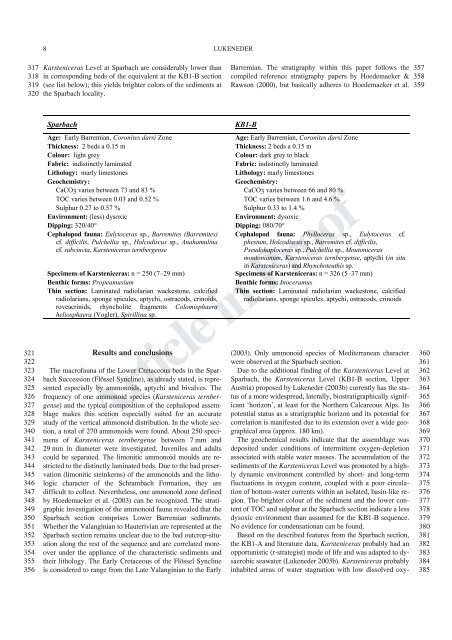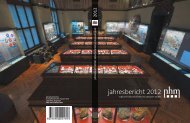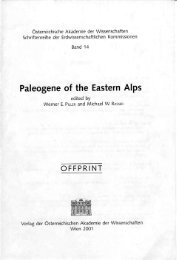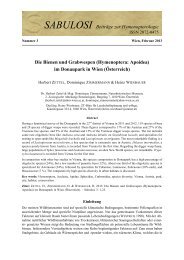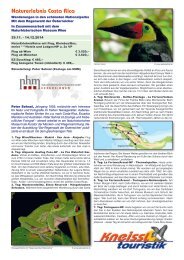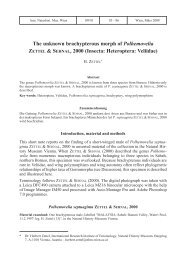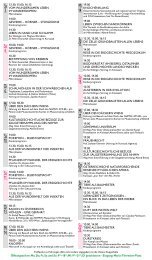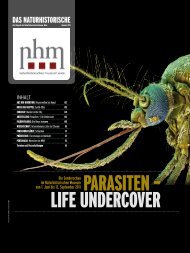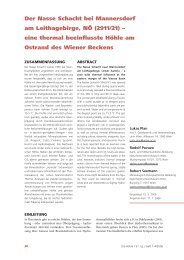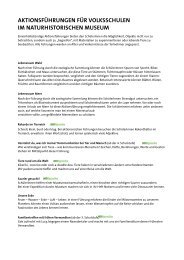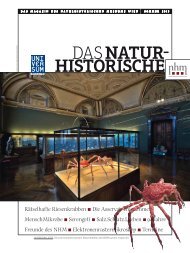Lukeneder pdf - Naturhistorisches Museum Wien
Lukeneder pdf - Naturhistorisches Museum Wien
Lukeneder pdf - Naturhistorisches Museum Wien
You also want an ePaper? Increase the reach of your titles
YUMPU automatically turns print PDFs into web optimized ePapers that Google loves.
317<br />
318<br />
319<br />
320<br />
321<br />
322<br />
323<br />
324<br />
325<br />
326<br />
327<br />
328<br />
329<br />
340<br />
341<br />
342<br />
343<br />
344<br />
345<br />
346<br />
347<br />
348<br />
349<br />
350<br />
351<br />
352<br />
353<br />
354<br />
355<br />
356<br />
8 LUKENEDER<br />
Karsteniceras Level at Sparbach are considerably lower than<br />
in corresponding beds of the equivalent at the KB1-B section<br />
(see list below); this yields brighter colors of the sediments at<br />
the Sparbach locality.<br />
Sparbach KB1-B<br />
Age: Early Barremian, Coronites darsi Zone Age: Early Barremian, Coronites darsi Zone<br />
Thickness: 2 beds a 0.15 m Thickness: 2 beds a 0.15 m<br />
Colour: light grey Colour: dark grey to black<br />
�abric: indistinctly laminated �abric: indistinctly laminated<br />
Lithology: marly limestones Lithology: marly limestones<br />
Geochemistry: Geochemistry:<br />
CaCO3 varies between 73 and 83 % CaCO3 varies between 66 and 80 %<br />
TOC varies between 0.03 and 0.52 % TOC varies between 1.6 and 4.6 %<br />
Sulphur 0.27 to 0.57 % Sulphur 0.33 to 1.4 %<br />
Environment: (less) dysoxic Environment: dysoxic<br />
Dipping: 320/40° Dipping: 080/70°<br />
Cephalopod fauna: Eulytoceras sp., Barremites (Barremites)<br />
cf. difficilis, Pulchellia sp., Holcodiscus sp., Anahamulina<br />
cf. subcincta, Karsteniceras ternbergense<br />
Cephalopod fauna: Phylloceras sp., Eulytoceras cf.<br />
phestum, Holcodiscus sp., Barremites cf. difficilis,<br />
Pseudohaploceras sp., Pulchellia sp., Moutoniceras<br />
moutonianum, Karsteniceras ternbergense, aptychi (in situ<br />
in Karsteniceras) and Rhynchoteuthis sp.<br />
Specimens of Karsteniceras: n = 250 (7–29 mm) Specimens of Karsteniceras: n = 326 (5–37 mm)<br />
Benthic forms: Propeamusium Benthic forms: Inoceramus<br />
Thin section: Laminated radiolarian wackestone, calcified Thin section: Laminated radiolarian wackestone, calcified<br />
radiolarians, sponge spicules, aptychi, ostracods, crinoids, radiolarians, sponge spicules, aptychi, ostracods, crinoids<br />
roveacrinids, rhyncholite fragments Colomisphaera<br />
heliosphaera (Vogler), Spirillina sp.<br />
Results and conclusions<br />
The macrofauna of the Lower Cretaceous beds in the Sparbach<br />
Succession (�lössel Syncline), as already stated, is represented<br />
especially by ammonoids, aptychi and bivalves. The<br />
frequency of one ammonoid species (Karsteniceras ternbergense)<br />
and the typical composition of the cephalopod assemblage<br />
makes this section especially suited for an accurate<br />
Article in Proof<br />
study of the vertical ammonoid distribution. In the whole sec-<br />
tion, a total of 270 ammonoids were found. About 250 specimens<br />
of Karsteniceras ternbergense between 7 mm and<br />
29 mm in diameter were investigated. Juveniles and adults<br />
could be separated. The limonitic ammonoid moulds are restricted<br />
to the distinctly laminated beds. Due to the bad preservation<br />
(limonitic steinkerns) of the ammonoids and the lithologic<br />
character of the Schrambach �ormation, they are<br />
difficult to collect. Nevertheless, one ammonoid zone defined<br />
by Hoedemaeker et al. (2003) can be recognized. The stratigraphic<br />
investigation of the ammonoid fauna revealed that the<br />
Sparbach section comprises Lower Barremian sediments.<br />
Whether the Valanginian to Hauterivian are represented at the<br />
Sparbach section remains unclear due to the bad outcrop-situation<br />
along the rest of the sequence and are correlated moreover<br />
under the appliance of the characteristic sediments and<br />
their lithology. The Early Cretaceous of the �lössel Syncline<br />
is considered to range from the Late Valanginian to the Early<br />
Barremian. The stratigraphy within this paper follows the<br />
compiled reference stratigraphy papers by Hoedemaeker &<br />
Rawson (2000), but basically adheres to Hoedemaeker et al.<br />
(2003). Only ammonoid species of Mediterranean character<br />
were observed at the Sparbach section.<br />
Due to the additional finding of the Karsteniceras Level at<br />
Sparbach, the Karsteniceras Level (KB1-B section, Upper<br />
Austria) proposed by <strong>Lukeneder</strong> (2003b) currently has the status<br />
of a more widespread, laterally, biostratigraphically significant<br />
‘horizon’, at least for the Northern Calcareous Alps. Its<br />
potential status as a stratigraphic horizon and its potential for<br />
correlation is manifested due to its extension over a wide geographical<br />
area (approx. 180 km).<br />
The geochemical results indicate that the assemblage was<br />
deposited under conditions of intermittent oxygen-depletion<br />
associated with stable water masses. The accumulation of the<br />
sediments of the Karsteniceras Level was promoted by a highly<br />
dynamic environment controlled by short- and long-term<br />
fluctuations in oxygen content, coupled with a poor circulation<br />
of bottom-water currents within an isolated, basin-like region.<br />
The brighter colour of the sediment and the lower content<br />
of TOC and sulphur at the Sparbach section indicate a less<br />
dysoxic environment than assumed for the KB1-B sequence.<br />
No evidence for condensationan can be found.<br />
Based on the described features from the Sparbach section,<br />
the KB1-A and literature data, Karsteniceras probably had an<br />
opportunistic (r-strategist) mode of life and was adapted to dysaerobic<br />
seawater (<strong>Lukeneder</strong> 2003b). Karsteniceras probably<br />
inhabited areas of water stagnation with low dissolved oxy-<br />
357<br />
358<br />
359<br />
360<br />
361<br />
362<br />
363<br />
364<br />
365<br />
366<br />
367<br />
368<br />
369<br />
370<br />
371<br />
372<br />
373<br />
374<br />
375<br />
376<br />
377<br />
378<br />
379<br />
380<br />
381<br />
382<br />
383<br />
384<br />
385


